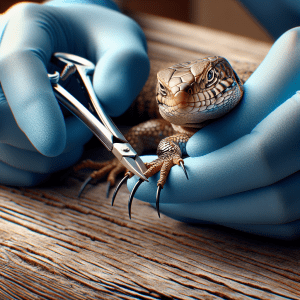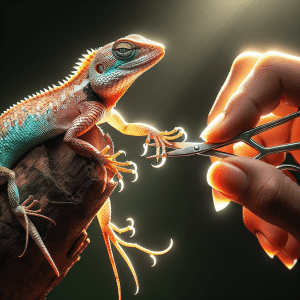Introduction: Importance of Nail Trimming for Lizards
Do you know that nail trimming is not just for us humans, but it’s also crucial for our scaly friends? Lizards, like us, need proper nail care to stay healthy and happy. It’s like getting a fresh manicure, but for your reptile buddy!
Let me share a personal anecdote with you. I remember when I first got my bearded dragon, Spike. I noticed that his nails were getting a bit too long, and I wasn’t sure if I should trim them or not. I did some research and learned about the importance of nail trimming for lizards. It was a bit nerve-wracking at first, but once I got the hang of it, Spike was much more comfortable and active.
Understanding the anatomy of a lizard’s nails is key to providing them with the proper care they need. Lizard nails are made of keratin, just like our nails, but they can vary in size and shape depending on the species. Knowing how their nails are structured will help you trim them safely and effectively.
When it comes to tools needed for trimming lizard nails, you’ll want to have the right equipment on hand. From specialized clippers to styptic powder in case of any accidental nicks, being prepared will make the nail trimming process smoother for both you and your lizard pal.
Stay tuned as we dive into the step-by-step guide for trimming a lizard’s nails. It’s a delicate process that requires patience and precision, but with the right technique, you’ll be a pro in no time. Remember, a well-trimmed set of nails can prevent injuries and discomfort for your lizard, so it’s well worth the effort.
Are you ready to give your lizard a mini spa day with a nail trimming session? Let’s make sure those claws are in tip-top shape for all their climbing and exploring adventures!
Understanding the Anatomy of a Lizard’s Nails
Have you ever stopped to think about the intricate anatomy of a lizard’s nails? It’s truly fascinating how these tiny structures play such a crucial role in their everyday lives. Picture this: imagine holding a lizard in your hands and observing the fine details of their nails. Each nail is designed for a specific purpose, aiding in their mobility, grip, and overall well-being.
Lizards have evolved over millions of years, adapting to their environments with precision. Their nails are not just for show; they serve a functional purpose in their survival. From climbing trees to digging burrows, a lizard’s nails are essential tools for navigating their surroundings. It’s like having built-in equipment that helps them thrive in the wild.
Understanding the anatomy of a lizard’s nails goes beyond surface-level observation. It delves into the intricate structures that have evolved to meet the unique needs of each lizard species. Did you know that certain lizards have specialized nails for different purposes? Some have sharp, curved nails for climbing, while others have blunt, sturdy nails for digging. It’s a testament to the diversity and adaptability of these fascinating creatures.
As we explore the anatomy of a lizard’s nails, we gain a deeper appreciation for the complexity of nature. The next time you observe a lizard scurrying across the ground or clinging to a branch, take a moment to marvel at the intricate design of their nails. It’s a reminder of the beauty and functionality that exists in the natural world, waiting to be discovered and appreciated.
Tools Needed for Trimming Lizard Nails
You know, when it comes to trimming your lizard’s nails, having the right tools is key. It’s like trying to build furniture without a screwdriver – you just can’t do it! So, let’s dive into the essential tools you’ll need for this important task.
First off, a good pair of nail clippers specifically designed for reptiles is a must-have. These clippers are usually smaller and more precise than the ones we use for ourselves. Trust me, using the right tool makes the job so much easier and safer for your little scaled buddy.
Next up, you’ll want to have some styptic powder on hand. Now, this might sound like a fancy term, but it’s basically a magical substance that helps stop bleeding in case you accidentally nick the quick (the sensitive part of the nail that contains blood vessels). It’s like having a first aid kit for your lizard’s nails!
Oh, and don’t forget a small towel or cloth to gently wrap your lizard in. This helps keep them calm and secure during the nail trimming process. Think of it as giving them a cozy little lizard burrito while you work your magic on their nails.
Lastly, having a bright light source nearby is super helpful. Lizard nails can be quite tiny and translucent, so good lighting will ensure you can see exactly where to trim without any guesswork. Plus, it’s like setting the stage for a successful nail trimming performance!
So, there you have it – the essential tools for trimming your lizard’s nails like a pro. With these items in your arsenal, you’ll be well-equipped to keep your scaly friend’s claws in tip-top shape.
Step-by-Step Guide to Trimming a Lizard’s Nails
Oh, trimming a lizard’s nails can be quite the adventure! Let me walk you through the step-by-step guide to trimming those tiny reptile claws. First off, you’ll need to gather your tools – a pair of small pet nail clippers or a nail file will do the trick. Remember the time I tried using regular human clippers? Let’s just say it didn’t go as planned!
Next, gently hold your lizard in a comfortable position. It’s essential to keep them relaxed and secure during the process. Now, here comes the tricky part – identifying the quick in their nails. You definitely don’t want to cut into that sensitive part, so proceed with caution.
When you’re ready, carefully trim the tip of each nail, aiming to avoid any blood vessels. If you’re unsure, it’s always better to trim less than risk cutting too much. And hey, don’t forget to give your lizard some treats or positive reinforcement afterward. A little snack can go a long way in making nail trimming a more pleasant experience for your scaly friend.
Have you ever heard of the “invisible quick” phenomenon in lizards? It’s fascinating how some lizards have nails with translucent tips, making it challenging to spot the quick. This can make nail trimming a bit more challenging, but with practice and patience, you’ll get the hang of it.
Remember, nail trimming is not just about aesthetics – it’s crucial for your lizard’s health and well-being. Overgrown nails can lead to discomfort and even affect their mobility. By regularly maintaining their nails, you’re helping your lizard stay active and happy.
So, the next time you embark on a lizard nail trimming session, approach it with confidence and care. Your scaly companion will thank you for keeping their claws in top shape!
Safety Precautions to Consider Before Nail Trimming
Have you ever tried trimming the nails of a lizard? It can be quite a tricky task, but with the right tools and techniques, it can be done smoothly. Before diving into the nail trimming process, let’s talk about the safety precautions that you need to consider.
When it comes to trimming a lizard’s nails, safety should always be a top priority. These little reptiles may not be too keen on having their nails trimmed, so it’s essential to handle them with care. One practical tip to ensure safety is to have a firm grip on your lizard while trimming its nails. This will prevent any sudden movements that could potentially harm the lizard or cause accidental cuts.
Another safety precaution to keep in mind is to use the appropriate tools for the job. Lizard nail clippers or small pet nail trimmers are ideal for this task. Avoid using human nail clippers as they may not be suitable for the size and shape of a lizard’s nails. By using the right tools, you can ensure a precise and safe nail trimming experience for your lizard.
Additionally, it’s crucial to have some styptic powder or cornstarch on hand in case you accidentally cut the quick of the nail. This can help stop any bleeding quickly and prevent any discomfort for your lizard.
Now, let’s talk about the right environment for nail trimming. Choose a quiet and calm space where your lizard feels comfortable. A soft surface like a towel or blanket can provide a secure grip for your lizard and prevent any slipping during the nail trimming process.
By following these safety precautions and tips, you can make the nail trimming experience a stress-free and safe one for both you and your lizard. Remember, patience is key when it comes to nail trimming, so take your time and proceed with caution. Your lizard will thank you for the well-maintained nails and a comfortable nail trimming experience.
Common Mistakes to Avoid During Lizard Nail Trimming
Have you ever trimmed your lizard’s nails and ended up making a mistake? It happens to the best of us! In this section, we’ll delve into common mistakes to avoid during lizard nail trimming to ensure a smooth and stress-free process for both you and your scaly friend.
One of the most frequent blunders that lizard owners make is trimming the nails too short. It can be tempting to cut the nails as short as possible to avoid frequent trims, but this can lead to pain and bleeding for your lizard. Remember, the goal is to maintain a healthy nail length, not to eliminate the need for future trims altogether.
Another common mistake is using improper tools for nail trimming. Lizard nails are delicate and can easily splinter or crack if cut with dull or inappropriate clippers. Always opt for specialized reptile nail clippers or small, sharp scissors designed for pet nail care to ensure a clean and precise cut without causing harm to your lizard.
Furthermore, rushing through the nail trimming process can result in accidental cuts or injuries. Take your time and approach the task with patience and care. If your lizard becomes agitated or restless during the trimming session, it’s best to pause and resume when they are calmer to avoid any accidents.
Lastly, neglecting to provide post-trim care for your lizard’s nails is a common oversight. After trimming, inspect the nails for any sharp edges or uneven cuts that may need smoothing out. You can use a nail file or emery board to gently buff any rough areas and ensure a comfortable finish for your lizard.
By being mindful of these common mistakes and taking the necessary precautions, you can make the nail trimming experience a positive one for both you and your lizard. Remember, patience and careful attention to detail are key to successful nail maintenance for your scaly companion!
Tips for Soothing a Lizard After Nail Trimming
Have you ever seen a lizard frantically running around after a nail trimming session? It can be quite a sight! Just like us, lizards may feel a bit uneasy after their nails have been trimmed. So, I wanted to share some tips on how to soothe your lizard post-nail trimming to make the experience as stress-free as possible for both of you.
One practical tip is to ensure that your lizard has a comfortable and familiar environment to retreat to after the nail trimming session. Lizards are creatures of habit, and providing them with a cozy spot to relax can help them feel secure and calm. You might want to set up a warm basking area with some of their favorite hiding spots to help them unwind.
Another helpful trick is to offer your lizard some tasty treats as a reward for enduring the nail trimming process. Lizards can be motivated by food, so offering them a small snack can help distract them and create a positive association with the experience. Just make sure to choose treats that are safe and appropriate for your specific lizard species.
Additionally, it’s essential to handle your lizard gently and avoid any sudden movements or loud noises after the nail trimming session. Remember, they may still be feeling a bit vulnerable, so a calm and quiet environment is key to helping them relax and recover.
By following these tips, you can help your lizard feel more at ease after a nail trimming session and strengthen your bond with your scaly friend. Just like us, lizards appreciate a little TLC after a grooming session, so don’t forget to shower them with love and care to make the experience as pleasant as possible.
Frequency of Nail Trimming for Different Lizard Species
When it comes to the frequency of nail trimming for different lizard species, there’s a lot to consider. You know, it’s not a one-size-fits-all situation! I remember when I first got my bearded dragon, I had no idea how often I should be trimming his nails. It was quite the learning curve!
Did you know that different lizard species have varying growth rates for their nails? It’s fascinating how each species has its own unique needs when it comes to nail maintenance. For instance, some lizards may require more frequent trimming due to faster nail growth, while others can go longer between trimmings.
One practical tip I’ve found helpful is to observe your lizard’s behavior and nail length regularly. By keeping an eye on how quickly their nails are growing and checking for any signs of overgrowth, you can better gauge when it’s time for a trim. It’s all about being proactive and attentive to your pet’s needs.
So, here’s a question to ponder: Have you ever wondered why some lizards need more frequent nail trims than others? It really makes you appreciate the diversity and complexity of these amazing creatures. Understanding the specific nail care requirements of your lizard species is crucial for their overall health and well-being.
By tailoring your nail trimming schedule to fit the needs of your particular lizard species, you can ensure that your scaly friend stays comfortable and healthy. Plus, it’s a great way to bond with your pet and show them some extra love and care. Remember, a well-groomed lizard is a happy lizard!
Alternatives to Traditional Nail Trimming Techniques
Have you ever wondered if there are alternative methods to traditional nail trimming for lizards? Well, let me tell you about some interesting options that might just surprise you!
When it comes to maintaining your lizard’s nails, not everyone is comfortable with using clippers or scissors. Some lizards can be quite fidgety during nail trims, making the process stressful for both the pet and the owner. This is where exploring alternative nail trimming techniques can come in handy.
One practical tip that many lizard owners find useful is utilizing a nail file or emery board. Yes, you heard that right – just like how we file our nails, you can gently file down your lizard’s nails to keep them at a manageable length. It may take a bit longer compared to using clippers, but it can be a less intimidating option for both you and your scaly friend.
Another interesting fact about alternative nail trimming methods is the use of special substrates or surfaces within your lizard’s habitat. By providing rough surfaces like rocks or logs for your lizard to climb and walk on, you can naturally wear down their nails over time. This can be a more passive way to help maintain nail length without the need for frequent trims.
So, the next time you’re thinking about trimming your lizard’s nails, consider these alternative approaches to make the process easier and less stressful for both you and your pet. Whether you opt for a nail file, incorporate rough surfaces in their habitat, or combine different techniques, finding what works best for your lizard is key to keeping their nails healthy and your bond strong.
Maintaining Healthy Nails for Happy Lizards
Lizard nail trimming may seem like a daunting task, but with the right knowledge and tools, you can keep your scaly friend’s nails in top shape. Let me share some insights on the frequency of nail trimming for different lizard species.
Have you ever wondered how often you should trim your lizard’s nails based on its species? Well, it turns out that various lizard species have different nail growth rates and behaviors. For instance, arboreal lizards like geckos and anoles may need more frequent nail trimming due to their constant climbing activities. On the other hand, ground-dwelling lizards such as bearded dragons or skinks might require less frequent trimming as their nails wear down naturally through burrowing or walking on rough surfaces.
Understanding the nail growth patterns of your specific lizard species is crucial in determining the ideal frequency for nail trimming. By observing your pet’s nail length and behavior, you can gauge when it’s time for a trim. Keeping a close eye on your lizard’s nails will help prevent overgrowth, which can lead to discomfort or potential health issues.
Additionally, consider seeking advice from a reptile veterinarian or experienced reptile keepers to learn more about the optimal nail trimming schedule for your lizard. These experts can provide valuable insights tailored to your lizard’s individual needs, ensuring proper nail care and overall well-being.
Remember, regular nail maintenance is essential for your lizard’s health and comfort. By staying proactive and informed about the nail trimming requirements of your specific lizard species, you can help your scaly companion stay happy and healthy for years to come. So, keep those nail clippers handy and give your lizard’s nails the attention they deserve!




